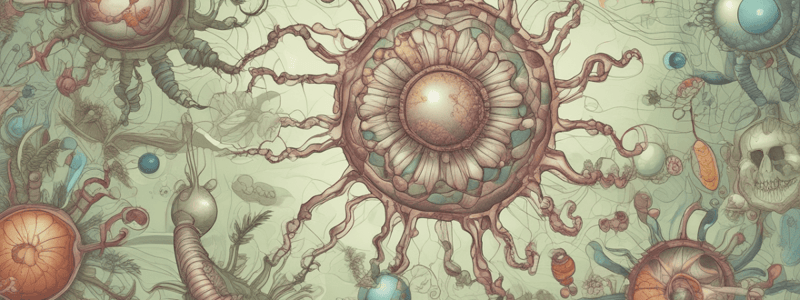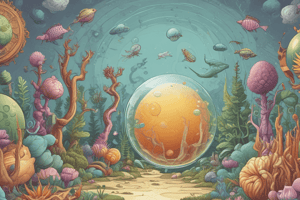Podcast
Questions and Answers
What is the study of the structure and function of biological molecules, such as DNA and proteins?
What is the study of the structure and function of biological molecules, such as DNA and proteins?
- Ecology
- Molecular Biology (correct)
- Microbiology
- Genetics
Which molecule provides energy and structure for living organisms?
Which molecule provides energy and structure for living organisms?
- Proteins
- Nucleic Acids
- Lipids
- Carbohydrates (correct)
What is the site of cellular respiration, where energy is generated for the cell?
What is the site of cellular respiration, where energy is generated for the cell?
- Mitochondria (correct)
- Nucleus
- Cytoplasm
- Ribosomes
What is the theory that explains how species change over time through natural selection, genetic drift, mutation, and gene flow?
What is the theory that explains how species change over time through natural selection, genetic drift, mutation, and gene flow?
What is the movement of genes from one population to another?
What is the movement of genes from one population to another?
What is the variety of different species, ecosystems, and genes within an ecosystem?
What is the variety of different species, ecosystems, and genes within an ecosystem?
What is the study of the relationships between living organisms and their environment?
What is the study of the relationships between living organisms and their environment?
What is the site of protein synthesis?
What is the site of protein synthesis?
Flashcards are hidden until you start studying
Study Notes
What is Biology?
- Biology is the scientific study of life and living organisms, including their structure, function, growth, evolution, distribution, and taxonomy.
- It explores the diversity of life forms, from molecules to ecosystems, and examines the interactions between living organisms and their environment.
Branches of Biology
- Botany: study of plants and plant-like organisms
- Zoology: study of animals and animal-like organisms
- Microbiology: study of microorganisms, such as bacteria and viruses
- Ecology: study of the relationships between living organisms and their environment
- Genetics: study of heredity, genes, and genetic variation
- Biochemistry: study of the chemical processes that occur within living organisms
- Molecular Biology: study of the structure and function of biological molecules, such as DNA and proteins
- Evolutionary Biology: study of the processes that have shaped the diversity of life on Earth
Biological Molecules
- Carbohydrates: provide energy and structure for living organisms
- Proteins: perform a wide range of functions, including catalyzing metabolic reactions and replicating DNA
- Lipids: provide energy and structure for living organisms
- Nucleic Acids: contain genetic information and provide instructions for the development and function of living organisms
Cell Structure and Function
- Cellular Organisms: composed of one or more cells
- Cell Membrane: regulates the flow of materials in and out of the cell
- Cytoplasm: site of metabolic reactions and cellular processes
- Nucleus: contains genetic material (DNA)
- Mitochondria: site of cellular respiration, where energy is generated for the cell
- Ribosomes: site of protein synthesis
Evolution
- Charles Darwin's Theory of Evolution: species change over time through natural selection, genetic drift, mutation, and gene flow
- Mechanisms of Evolution:
- Natural Selection: individuals with favorable traits are more likely to survive and reproduce
- Genetic Drift: random change in the frequency of a gene or genetic trait
- Mutation: change in the DNA sequence of an individual
- Gene Flow: movement of genes from one population to another
Ecosystems
- Ecosystem: community of living and non-living components interacting with each other
- Energy Flow: energy is transferred from one organism to another through food chains and food webs
- Nutrient Cycles: nutrients are recycled through the ecosystem through processes such as decomposition and nutrient uptake
- Biodiversity: variety of different species, ecosystems, and genes within an ecosystem
What is Biology?
- Biology is the scientific study of life and living organisms, including their structure, function, growth, evolution, distribution, and taxonomy.
- It explores the diversity of life forms, from molecules to ecosystems, and examines the interactions between living organisms and their environment.
Branches of Biology
- Botany: study of plants and plant-like organisms
- Zoology: study of animals and animal-like organisms
- Microbiology: study of microorganisms, such as bacteria and viruses
- Ecology: study of the relationships between living organisms and their environment
- Genetics: study of heredity, genes, and genetic variation
- Biochemistry: study of the chemical processes that occur within living organisms
- Molecular Biology: study of the structure and function of biological molecules, such as DNA and proteins
- Evolutionary Biology: study of the processes that have shaped the diversity of life on Earth
Biological Molecules
- Carbohydrates: provide energy and structure for living organisms
- Proteins: perform a wide range of functions, including catalyzing metabolic reactions and replicating DNA
- Lipids: provide energy and structure for living organisms
- Nucleic Acids: contain genetic information and provide instructions for the development and function of living organisms
Cell Structure and Function
- Cellular Organisms: composed of one or more cells
- Cell Membrane: regulates the flow of materials in and out of the cell
- Cytoplasm: site of metabolic reactions and cellular processes
- Nucleus: contains genetic material (DNA)
- Mitochondria: site of cellular respiration, where energy is generated for the cell
- Ribosomes: site of protein synthesis
Evolution
- Charles Darwin's Theory of Evolution: species change over time through natural selection, genetic drift, mutation, and gene flow
- Mechanisms of Evolution:
- Natural Selection: individuals with favorable traits are more likely to survive and reproduce
- Genetic Drift: random change in the frequency of a gene or genetic trait
- Mutation: change in the DNA sequence of an individual
- Gene Flow: movement of genes from one population to another
Ecosystems
- Ecosystem: community of living and non-living components interacting with each other
- Energy Flow: energy is transferred from one organism to another through food chains and food webs
- Nutrient Cycles: nutrients are recycled through the ecosystem through processes such as decomposition and nutrient uptake
- Biodiversity: variety of different species, ecosystems, and genes within an ecosystem
Studying That Suits You
Use AI to generate personalized quizzes and flashcards to suit your learning preferences.




